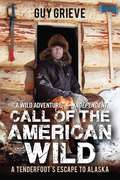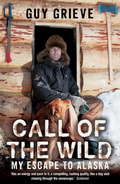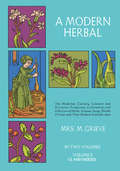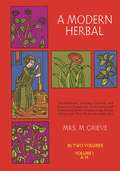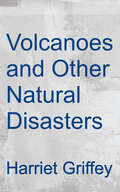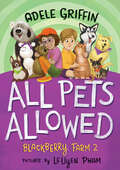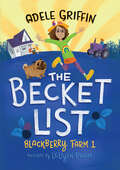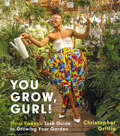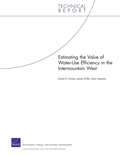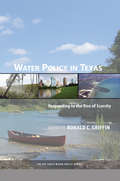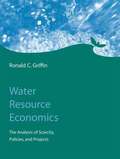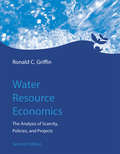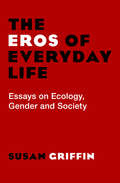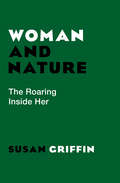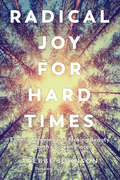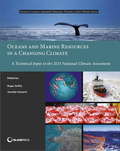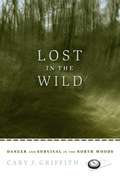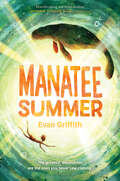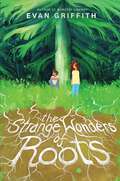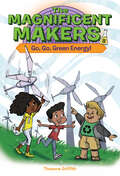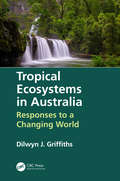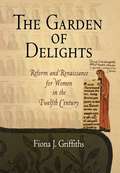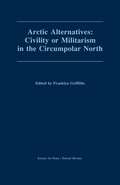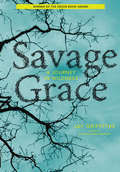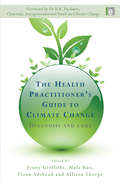- Table View
- List View
Call of the American Wild: A Tenderfoot's Escape to Alaska
by Guy Grieve"A wild adventure. ” --Independent A man, an axe, and a dog named Fuzzy . . . let the adventure begin! Trapped in a job he hated and up to his neck in debt, Guy Grieve’s life was going nowhere. But with a stroke of luck, his dream of escaping it all to live in the remote Alaskan tundra suddenly came true. Miles from the nearest human being and armed with only the most basic equipment, Guy built a log cabin from scratch and began carving a life for himself through fishing, hunting, and diligently avoiding bears. Packed with adventure, humor, and insight, this is the gripping story of an ordinary man learning the ways of the wild.
Call of the Wild: My Escape to Alaska
by Guy GrieveGuy Grieve's life was going nowhere - trapped in a job he hated, commuting 2,000 miles a month and up to his neck in debt. But he dreamed of escaping it all to live alone in one of the wildest, most remote places on earth - Alaska. And just when he'd given up hope, the dream came true. Suddenly Guy was thrown into one of the harshest environments in the world, miles from the nearest human being and armed with only the most basic equipment. And he soon found - whether building a log cabin from scratch, hunting, ice fishing or of course dodging bears in the buff - that life in the wilderness was anything but easy...Part Ray Mears, part Bill Bryson, CALL OF THE WILD is the gripping story of how a mild-mannered commuter struggled with the elements - and himself - and eventually learned the ways of the wild.
A Modern Herbal: Vol. II
by Margaret GrieveIf you want to know how pleurisy root, lungwort, and abscess root got their names, how poison ivy used to treat rheumatism, or how garlic guarded against the Bubonic Plague, consult A Modern Herbal. This 20th-century version of the medieval Herbal is as rich in scientific fact and folklore as its predecessors and is equally encyclopedic in coverage. From aconite to zedoary, not an herb, grass, fungus, shrub or tree is overlooked; and strange and wonderful discoveries about even the most common of plants await the reader.Traditionally, an herbal combined the folk beliefs and tales about plants, the medicinal properties (and parts used) of the herbs, and their botanical classification. But Mrs. Grieve has extended and enlarged the tradition; her coverage of asafetida, bearberry, broom, chamomile, chickweed, dandelion, dock, elecampane, almond, eyebright, fenugreek, moss, fern, figwort, gentian, Hart's tongue, indigo, acacia, jaborandi, kava kava, lavender, pimpernel, rhubarb, squill, sage, thyme, sarsaparilla, unicorn root, valerian, woundwort, yew, etc. — more than 800 varieties in all — includes in addition methods of cultivation; the chemical constituents, dosages, and preparations of extracts and tinctures, unknown to earlier herbalists; possible economic and cosmetic properties, and detailed illustrations, from root to bud, of 161 plants.Of the many exceptional plants covered in Herbal, perhaps the most fascinating are the poisonous varieties — hemlock, poison oak, aconite, etc. — whose poisons, in certain cases, serve medical purposes and whose antidotes (if known) are given in detail. And of the many unique features, perhaps the most interesting are the hundreds of recipes and instructions for making ointments, lotions, sauces, wines, and fruit brandies like bilberry and carrot jam, elderberry and mint vinegar, sagina sauce, and cucumber lotion for sunburn; and the hundreds of prescriptions for tonics and liniments for bronchitis, arthritis, dropsy, jaundice, nervous tension, skin disease, and other ailments. 96 plates, 161 illustrations.
A Modern Herbal
by Margaret GrieveIf you want to know how pleurisy root, lungwort, and abscess root got their names, how poison ivy used to treat rheumatism, or how garlic guarded against the Bubonic Plague, consult A Modern Herbal. This 20th-century version of the medieval Herbal is as rich in scientific fact and folklore as its predecessors and is equally encyclopedic in coverage. From aconite to zedoary, not an herb, grass, fungus, shrub or tree is overlooked; and strange and wonderful discoveries about even the most common of plants await the reader.Traditionally, an herbal combined the folk beliefs and tales about plants, the medicinal properties (and parts used) of the herbs, and their botanical classification. But Mrs. Grieve has extended and enlarged the tradition; her coverage of asafetida, bearberry, broom, chamomile, chickweed, dandelion, dock, elecampane, almond, eyebright, fenugreek, moss, fern, figwort, gentian, Hart's tongue, indigo, acacia, jaborandi, kava kava, lavender, pimpernel, rhubarb, squill, sage, thyme, sarsaparilla, unicorn root, valerian, woundwort, yew, etc. — more than 800 varieties in all — includes in addition methods of cultivation; the chemical constituents, dosages, and preparations of extracts and tinctures, unknown to earlier herbalists; possible economic and cosmetic properties, and detailed illustrations, from root to bud, of 161 plants.Of the many exceptional plants covered in Herbal, perhaps the most fascinating are the poisonous varieties — hemlock, poison oak, aconite, etc. — whose poisons, in certain cases, serve medical purposes and whose antidotes (if known) are given in detail. And of the many unique features, perhaps the most interesting are the hundreds of recipes and instructions for making ointments, lotions, sauces, wines, and fruit brandies like bilberry and carrot jam, elderberry and mint vinegar, sagina sauce, and cucumber lotion for sunburn; and the hundreds of prescriptions for tonics and liniments for bronchitis, arthritis, dropsy, jaundice, nervous tension, skin disease, and other ailments. 96 plates, 161 illustrations.
Volcanoes and Other Natural Disasters (Dk Readers Series Dorling Kindersley Readers)
by Harriet Griffey Dorling Kindersley Publishing StaffDescribes natural disasters which have occurred in various places throughout the world including the eruption of Vesuvius in 79 A.D., the Yellow River flood in 1887, and the Australian bush fires in 1983.
All Pets Allowed: Blackberry Farm 2
by Adele GriffinNew dog, no tricks! Becket Branch has one birthday wish—a dog! Dogs are outgoing and friendly, and they live life loud, just like Becket. Becket&’s twin, Nicholas, wants a pet more like him—a peaceful, quiet indoor cat. When their parents take them to the shelter to choose a dog and a cat, it should be Becket&’s biggest BEAUTIFUL ALERT ever. But Becket&’s dream dog, Dibs, turns out to be a super-shy scaredy-pooch. Meanwhile, Nicholas&’s kitty, Given, loves being the center of attention and greeting visitors to Blackberry Farm. Can Becket and Nicholas learn how to love Dibs and Given as they are—even if they aren&’t exactly the pets the twins dreamed of? With black-and-white drawings throughout by award-winning illustrator LeUyen Pham (Real Friends), this second volume of the Blackberry Farm series offers a gentle message about embracing new friends who may not match preconceived expectations.
The Becket List: A Blackberry Farm Story
by Adele GriffinAdventure and discover with the bold and intrepid Becket Branch when her family’s move from city to a country farm means big changes! Everything is changing for Becket Branch. From subways to sidewalks to safety rules, Becket is a city kid born and raised. Now the Branch family is trading urban bustle for big green fields and moving to Gran’s farm, where Becket has to make sense of new routines from feeding animals to baling hay. And as much as Becket loves to yell “Beautiful Alert!” there’s a lot about the countryside that is just plain odd. But Becket is ready to put her own spin on country life. Whether selling her mouth-puckering lemonade, feeding hostile hens, or trying to make a best friend of her new neighbor Frieda Franca, Becket is determined to use her city smarts to get a grip on farm living. Laugh and learn with Becket as she mucks through the messy, exuberant human experience of change she didn’t ask for, in a story that sparkles with quirky characters and lasting connections.
You Grow, Gurl!: Plant Kween's Guide to Growing Your Garden
by Christopher GriffinDiscover the joys and self-nurturing benefits of plant parenthood, from learning how to begin building your own lush plant family to getting into those fun tips on how to care for your green gurls, with this beautiful, illustrated guide from the dazzling creator of the @plantkween Instagram account. “We all love some new growth, dahling.”Six years ago, Christopher Griffin was just beginning the plant parenthood journey with one small Marble Queen Pothos. Today, this Black Queer non-binary femme plant influencer known as Plant Kween tends to a family of more than 200 healthy green gurls in the Brooklyn apartment they call home. You Grow, Gurl! is Kween’s fun and fabulous guide to becoming a plant parent and keeping your green gurls growing and thriving.Anyone can be a plant parent! It’s all about TLC—taking the time and energy to focus on a plant’s needs, and ultimately your own. Featuring 200 full-color photos and illustrations, practical instructions and tips—on everything from propagating to measuring humidity to repotting—activities, and stories, this fun and joyful guide shows how to green-up any space and have it serving those lush lewks. Self-care takes many forms and tending to your plants’ needs helps you grow too. In addition to information and advice on plant care, Kween provides meditations, mindfulness activities, playlists, and more to help you practice self-care through plant-care. As Kween says, “We can learn a lot about how we treat ourselves, how we treat others, and how we navigate the world from these green lil creatures.” Healing and growing your heart, body, and soul takes time, love, and focus. Taking care of plants teaches you to apply that same attention and love to yourself and helps you find new pathways to explore on your own botanical adventure to self-love.
Estimating the Value of Water-Use Efficiency in the Intermountain West
by James Griffin David G. Groves Sara HajiamiriThis report presents an economic framework for estimating a water agency's avoided costs and environmental benefits of increasing water-use efficiency. The report demonstrates this framework by evaluating the benefits of Denver Water's efficiency programs and utilizes an exploratory modeling approach to accommodate significant uncertainty. The analysis highlights the importance of considering both long- and short-run costs and benefits.
Water Policy in Texas: Responding to the Rise of Scarcity (Rff Press Water Policy Ser.)
by Ronald C. GriffinAs a water-scarce state with deep cultural attachments to private property rights, Texas has taken a unique evolutionary path with regard to water management. This new resource surveys past and current challenges for managing both groundwater and surface water, telling a comprehensive story about water policy in Texas, and identifying opportunities for improving future governance. Texas is the U.S. state that has experimented most thoroughly with water markets. In Water Policy in Texas, experts from broad disciplinary perspectives describe and analyze Texas water laws and management agencies, and the practices of water marketing and rate making in Texas. They explore the unique cases of the Edwards and Ogallala aquifers, the science and policy of environmental water stewardship, the extensive history of formalized water sharing with neighboring states and Mexico, and the opportunities for harnessing new technologies that might aid in addressing scarcity. This multidimensional, interdisciplinary book will be a valuable resource for students and researchers of Texas water policy, as well as for water managers worldwide, particularly those working within contexts of water scarcity.
Water Resource Economics: The Analysis of Scarcity, Policies, and Projects
by Ronald C. GriffinEconomics brings powerful insights to water management, but most water professionals receive limited training in it. This text offers a comprehensive development of water resource economics that is accessible to engineers and natural scientists as well as economists. The goal is to build a practical platform for understanding and performing economic analysis using both theoretical and empirical tools. The mathematics needed to understand the subjects covered in this text include basic optimization methods and integral calculus. Familiarity with microeconomics or natural resource economics is helpful, but all the economics needed is presented and developed progressively in the text. Many water-based example calculations are included. Thus the book can be used for independent study as well as course work. The book focuses on the scarcity of water quantity (rather than water quality). The author presents the economic theory of resource allocation, recognizing the peculiarities imposed by water, and expands the theory to encompass time-defined matters such as ground water depletion. He then discusses such subjects as institutional economics, water law, how economics is used in policy and cost-benefit analysis, the roles of water marketing and water pricing, demand and supply estimation, privatization, and modeling with demand and supply functions. As an aid to readers with specific interests, references to recent literature are given for all of these topics. Each chapter ends with a summary and exercises. All graphic portrayals of economic theory and most calculations are performed using Mathematica software. These programs are downloadable, but their use is entirely optional.
Water Resource Economics, second edition: The Analysis of Scarcity, Policies, and Projects
by Ronald C. GriffinUpdated edition of a comprehensive introduction to the economics of water management, with self-contained treatment of all necessary economic concepts.Economics brings powerful insights to water management, but most water professionals receive limited training in it. The second edition of this text offers a comprehensive development of water resource economics that is accessible to engineers and natural scientists as well as to economists. The goal is to build a practical platform for understanding and performing economic analysis using both theoretical and empirical tools. Familiarity with microeconomics or natural resource economics is helpful, but all the economics needed is presented and developed progressively in the text.The book focuses on the scarcity of water quantity (rather than on water quality). The author presents the economic theory of resource allocation, recognizing the peculiarities imposed by water, and then goes on to treat a range of subjects including conservation, groundwater depletion, water law, policy analysis, cost–benefit analysis, water marketing, privatization, and demand and supply estimation. Added features of this updated edition include a new chapter on water scarcity risk (with climate change and necessary risk tools introduced progressively) and new risk-attentive material elsewhere in the text; sharper treatment of block rates and pricing doctrine; expanded attention to contemporary literature and issues; and new appendixes on input–output analysis, water footprinting and virtual water, and cost allocation. Each chapter ends with a summary and exercises.
The Eros of Everyday Life: Essays on Ecology, Gender and Society
by Susan GriffinA brilliant collection of thought-provoking essays on gender, nature, passion, and society from an acclaimed feminist, philosopher, and poet In The Eros of Everyday Life, one of America's most provocative writers and thinkers offers insightful and compelling views on a wide range of social, ecological, and gender issues. From a distinctly feminist point of view, Susan Griffin explores the intricate connections between science and religion, nature and society, women and men, and love and consciousness. She brilliantly commingles lyrical memoir with cogent social commentary, producing a colorful literary tapestry that examines contemporary life and culture, its contradictions and complexities, and the rise of new ideologies. The Eros of Everyday Life showcases a decade's worth of the very best writing by this acclaimed Pulitzer Prize and National Book Critics Circle Award finalist. It is an enthralling anthology that reveals the ways in which Western society undermines itself by diminishing both woman and the natural environment, and yet it is also a celebration of the power of passion, and the remarkable evolution of the human capacity for love.
Woman and Nature: The Roaring Inside Her
by Susan GriffinA seminal work of the eco-feminist movement, connecting patriarchal society's mistreatment of women with its disregard for the Earth's ecological well-beingWoman and Nature draws from a vast and enthralling array of literary, scientific, and philosophical texts in order to explore the relationship between the denigration of women and the disregard for the Earth. In this singular work of love, passion, rage, and beauty, Susan Griffin ingeniously blends history, feminist philosophy, and environmental concerns, employing her acclaimed poetic sensibilities to question the mores of Western society. Griffin touches upon subjects as diverse as witch hunts, strip mining, Freudian psychology, and the suppression of sexuality to decry a long-standing history of misogyny and environmental abuse. A sometimes aggravating, often inspiring, and always insightful literary collage, this remarkable volume offers sanity, poetry, intelligence, and illumination.
Radical Joy for Hard Times: Finding Meaning and Making Beauty in Earth's Broken Places
by Susan Griffin Trebbe JohnsonIn a world devastated by human interaction and natural disaster—from clearcutting and fracking to extreme weather and urban sprawl—creating art, ritual, and even joy in wounded places is essential to our collective healing When a beloved place is decimated by physical damage, many may hit the donate button or call their congressperson. But award-winning author Trebbe Johnson argues that we need new methods for coping with these losses and invites readers to reconsider what constitutes “worthwhile action.” She discusses real wounded places ranging from weapons-testing grounds at Eglin Air Force Base, to Appalachian mountain tops destroyed by mining. These stories, along with tools for community engagement—ceremony, vigil, apology, and the creation of art with on-site materials—show us how we can find beauty in these places and discover new sources of meaning and community.
Oceans and Marine Resources in a Changing Climate
by Roger Griffis Jennifer HowardPrepared for the 2013 National Climate Assessment and a landmark study in terms of its breadth and depth of coverage, Oceans and Marine Resources in a Changing Climate is the result of a collaboration among numerous local, state, federal, and nongovernmental agencies to develop a comprehensive, state of the art look at the effects of climate change on the oceans and marine ecosystems under U. S. jurisdiction. This book provides an assessment of scientific knowledge of the current and projected impacts of climate change and ocean acidification on the physical, chemical, and biological components and human uses of marine ecosystems under U. S. jurisdiction. It also provides assessment of the international implications for the U. S. due to climate impacts on ocean ecosystems and of efforts to prepare for and adapt to climate and acidification impacts on ocean ecosystem, including · Climate-Driven Physical and Chemical Changes in Marine Ecosystems · Impacts of Climate Change on Marine Organisms · Impacts of Climate Change on Human Uses of the Ocean · International Implications of Climate Change · Ocean Management Challenges, Adaptation Approaches, and Opportunities in a Changing Climate · Sustaining the Assessment of Climate Impacts on Oceans and Marine Resources Rich in science and case studies, it examines the latest climate change impacts, scenarios, vulnerabilities, and adaptive capacity and offers decision makers and stakeholders a substantial basis from which to make informed choices that will affect the well-being of the region's inhabitants in the decades to come.
Lost in the Wild: Danger and Survival in the North Woods
by Cary J. GriffithIn the wilderness, one false step can make the difference between a delightful respite and a brush with death. On a beautiful summer afternoon in 1998, Dan Stephens, a 22-year-old canoeist, was leading a trip deep into Ontario's Quetico Provincial Park. He stepped into a gap among cedar trees to look for the next portage -- and did not return. More than four hours later, Dan awakened with a lump on his head from a fall and stumbled deeper into the woods, confused. Three years later, Jason Rasmussen, a third-year medical student who loved the forest's solitude, walked alone into the Boundary Waters Canoe Area Wilderness on a crisp fall day. After a two-day trek into a remote area of the woods, he stepped away from his campsite and made a series of seemingly trivial mistakes that left him separated from his supplies, wet, and lost, as cold darkness fell. Enduring days without food or shelter, these men faced the full harsh force of wilderness, the place that they had sought out for tranquil refuge from city life. Lost in the Wild takes readers with them as they enter realms of pain, fear, and courage, as they suffer dizzying confusion and unending frustration, and as they overcome seemingly insurmountable hurdles in a race to survive.
Manatee Summer
by Evan GriffithIn this poignant middle grade contemporary debut that New York Times bestselling author Katherine Applegate calls “by turns heartbreaking and heart-healing,” Evan Griffith beautifully captures all the tenderness and uncertainty that come with caring for family, friends, and the natural world.Peter and his best friend, Tommy, have a goal for their last summer before middle school: finish their Discovery Journal, a catalog of the wildlife around their Florida town. When they spot a manatee in a canal, Peter knows they’ve found something special—and when the manatee is injured by a boat, something to protect!As Peter joins the fight to save Florida manatees, he also finds himself taking care of his ailing grandfather and facing an unwelcome surprise that jeopardizes his friendship with Tommy. Soon Peter is adrift, navigating shifting tides and realizing that he has as much to discover about himself as he does about the world around him.
The Strange Wonders of Roots
by Evan GriffithFrom the acclaimed author of Manatee Summer comes a poignant story about a girl who learns to lay down roots as she’s drawn into a fight over a local grove of trees that’s in danger of being torn down. Perfect for fans of Hoot and Operation Redwood.Holly Foster knows that nothing lasts—not hometowns or schools, or even family. It’s just safer to keep herself uninvolved. So when she’s sent to spend part of the summer with her uncle, she knows better than to get attached to him…or any part of his small Vermont town of Arden.But when she arrives, she’s drawn into the drama that’s split the town: The local plastic factory is trying to tear down the trees in the center of Arden to build a visitor’s center and museum. Holly shocks herself by stepping into the fray and taking on one of the most powerful families in the area. But as she learns more about the town—and makes a new friend or two—Holly is determined to protect the one place she thinks she could finally belong. But will she be able to convince the other townspeople that the trees deserve to stay?
The Magnificent Makers #8: Go, Go, Green Energy! (The Magnificent Makers #8)
by Theanne GriffithBoom! Snap! Whiz! Zap! The Magnificent Makers is a fiction chapter book series filled with real science, adventure, and characters kids will love! Every book includes two science activities kids can do at home.A modern-day Magic School Bus for today's kids!Pablo, Violet, and their classmate Garry are on a field trip to the Environmental Science Center when they are transported to the Maker Maze! In the maze, they&’ll work with wacky scientist Dr. Crisp to complete three challenges all about wind, solar, and tidal energy. But then Violet begins to feel bad about how much energy she&’s been using. Can she, Pablo, and Garry learn how to use energy in a way that doesn't hurt the earth? In Go, Go, Green Energy!, the kids learn the importance of being mindful and never giving up. Don&’t miss the other books in the series! #1: How to Test a Friendship#2: Brain Trouble#3: Riding Sound Waves#4: The Great Germ Hunt#5: Race Through Space#6: Storm Chasers#7: Human Body Adventure
Tropical Ecosystems in Australia: Responses to a Changing World
by Dilwyn GriffithsOver the last century, the world has lived through changes more rapid than those experienced at any other time in human history, leading to pressing environmental problems and demands on the world’s finite resources. Nowhere is this more evident than across the world’s warm belt; a region likely to have the greatest problems and which is home to some of the world’s most disadvantaged people. This book reviews aspects of the biology of tropical ecosystems of northern Australia, as they have been affected by climatic, social and land-use changes. Tropical Australia can be regarded as a microcosm of the world’s tropics and as such, shares with other tropical regions many of the conflicts between various forms of development and environmental considerations. The book draws on a wide range of case studies of tropical Australian ecosystems ranging from coastal coral reefs and mangroves, known to be among the most vulnerable to the effects of the imposed changes, to cropping and pasture lands which, under careful management, have the potential remain as productive and sustainable agricultural or forestry ecosystems. Expert author Dilwyn Griffiths -emphasizes the importance of maintaining an active program for the establishment and management of national parks and environmental reserves -describes the effects of mining and other forms of industrial and urban development with particular reference to mine-site rehabilitation - explores problems relating to the restoration of marginally uneconomic farming land as alternative forms of land-use such as carbon farming through photosynthetically-driven carbon sequestration. This accessible reference work should find a place in educational libraries at all levels and become an essential resource for environmentalists and anyone with interests in various forms of land-use and development.
The Garden of Delights
by Fiona J. GriffithsIn The Garden of Delights, Fiona J. Griffiths offers the first major study of the Hortus deliciarum, a magnificently illuminated manuscript of theology, biblical history, and canon law written both by and explicitly for women at the end of the twelfth century. In so doing she provides a brilliantly persuasive new reading of female monastic culture. Through careful analysis of the contents, structure, and organization of the Hortus, Griffiths argues for women's profound engagement with the spiritual and intellectual vitality of the period on a level previously thought unimaginable, overturning the assumption that women were largely excluded from the "renaissance" and "reform" of this period. As a work of scholarship that drew from a wide range of sources, both monastic and scholastic, the Hortus provides a witness to the richness of women's reading practices within the cloister, demonstrating that it was possible, even late into the twelfth century, for communities of religious women to pursue an educational program that rivaled that available to men. At the same time, the manuscript's reformist agenda reveals how women engaged the pressing spiritual questions of the day, even going so far as to criticize priests and other churchmen who fell short of their reformist ideals.Through her wide-ranging examination of the texts and images of the Hortus, their sources, composition, and function, Griffiths offers an integrated understanding of the whole manuscript, one which highlights women's Latin learning and orthodox spirituality. The Garden of Delights contributes to some of the most urgent questions concerning medieval religious women, the interplay of gender, spirituality, and intellectual engagement, to discussions concerning women scribes and writers, women readers, female authorship and authority, and the visual culture of female communities. It will be of interest to art historians, scholars of women's and gender studies, historians of medieval religion, education, and theology, and literary scholars studying questions of female authorship and models of women's reading.
Arctic Alternatives: Civility of Militarism in the Circumpolar North
by Franklyn GriffithsThis book in itself is testimony to transition in the affairs of the north circumpolar region. Written in 1988 and updated in 1990, the papers assembled here have been overtaken by events. Non-military or civil requirements thus seemed to warrant a new and far more important place in our understanding of security. It’s appopriate to explore not only the potential of civil cooperation in countering the force of militarism, but the utility of a comprehensive conception of Arctic security. This book will look at how these views fare, once we’ve had a look at the region and its problems.
Savage Grace: A Journey in Wildness
by Jay GriffithsJay Griffiths is a tour guide for anyone who has ever wished to commune with the side of our human psyche that remains in touch with the wild. Equally at home among the "sea gypsy" Bajo people who live off the coast of Thailand and forage their food from the ocean floor, drinking the psychedelic ayahuasca plant with Amazonian shamans, or joining an Inuit whale hunt at the northern tip of Canada, Griffiths takes readers on an adventure both charted and un-chartable. She divides her meditations on these travels into sections named after the ancient elemental properties of the universe-Earth, Air, Fire, Ice, and Water-because her subject matter is not merely the places traveled to but the depths of mind and the cultural narratives revealed by place. It is a universal story told of far-flung groups of humans, with vastly different ways of life, connected through the varied wilderness that sustains them. By describing the ways in which human societies and the human mind have developed in response to the wilder elements of our homelands, Savage Grace reveals itself as a benediction for the emotional, intellectual, and physical nourishment that people continue to draw from the natural world. Under the sway of Griffiths' charisma, her poetic prose, and her deeply learned and persuasive case for the wild roots of our shared human being, we learn that we are all, each and every one of us, a force of nature.
The Health Practitioner's Guide to Climate Change: Diagnosis and Cure
by Jenny Griffiths Mala Rao Fiona Adshead Allison ThorpeHighly commended in the Public Health category, BMA Medical Awards 2010 There are enormous health benefits from tackling climate change. This is the first book to set out what health practitioners can do to prevent the worst impacts of climate change, to make health services sustainable, and to design healthy, sustainable communities. The book: - provides an introduction for health practitioners and students to climate change and its current and future health impacts - describes the relationship between health and the environment - gives facts and figures on greenhouse gas emissions - sets out the huge benefits to health of acting on climate change - explains what health practitioners can do - at home, at work and in their organizations, and - shows how you can support action in communities, nationally and globally. Essential reading for: - health professionals, local government, built environment professionals - students across all sectors of health, medicine and public administration - community and voluntary sector, NGOs - the business community involved in private healthcare. The Health Practitioner's Guide to Climate Change is written by an authoritative group of authors from key organisations in the field, including the Met Office, the Faculty of Public Health, Natural England, the London School of Hygiene and Tropical Medicine, the Climate and Health Council, the NHS Sustainable Development Unit, the Health Protection Agency, the University of the West of England, Sustrans and the National Social Marketing Centre. Sponsored by The National Heart Forum and the National Social Marketing Centre. Foreword by Dr. R.K. Pachauri, Director General, The Energy and Resources Institute (TERI) and Chairman, Intergovernmental Panel on Climate Change (IPCC)
